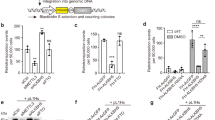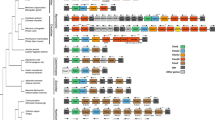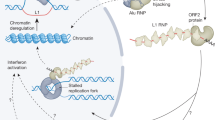Abstract
Retrotransposition affects genome structure by increasing repetition and producing insertional mutations1,2. Dispersion of the retrotransposon L1 throughout mammalian genomes suggests that L1 activity might be an important evolutionary force1. Here we report that L1 retrotransposition contributes to rapid genome evolution in the mouse, because a number of L1 sequences from the TF subfamily are retrotransposition competent. We show that the TF subfamily is large, young and expanding, containing approximately 4,800 full-length members in strain 129. Eleven randomly isolated, full-length TF elements averaged 99.8% sequence identity to each other, and seven of these retrotransposed in cultured cells. Thus, we estimate that the mouse genome contains approximately 3,000 active TF elements, 75 times the estimated number of active human L1s. Moreover, as TF elements are polymorphic among closely related mice, they have retrotransposed recently, implying rapid amplification of the subfamily to yield genomes with different patterns of interspersed repetition. Our data show that mice and humans differ considerably in the number of active L1s, and probably differ in the contribution of retrotransposition to ongoing sequence evolution.
This is a preview of subscription content, access via your institution
Access options
Subscribe to this journal
Receive 12 print issues and online access
$209.00 per year
only $17.42 per issue
Buy this article
- Purchase on Springer Link
- Instant access to full article PDF
Prices may be subject to local taxes which are calculated during checkout


Similar content being viewed by others
References
Hutchison, C.A. III, Hardies, S.C., Loeb, D.D., Shehee, W.R. & Edgell, M.H. LINEs and related retrotransposons: long interspersed repeated sequences in the eucaryotic genome. in Mobile DNA (eds Berg, D.E. & Howe, M.H.) 593–617 (Amer. Soc. Microbiol., Washington, DC, 1989).
Kazazian, H.H. & Moran, J.V. The impact of L1 retrotransposons on the human genome. Nature Genet. 19, 19–24 (1998).
Fanning, T.G. Size and structure of the highly-repetitive BamHI element in mice. Nucleic Acids Res. 11, 5073– 5091 (1983).
Loeb, D.D. et al. The sequence of a large L1Md element reveals a tandemly repeated 5' end and several features found in retrotransposons . Mol. Cell. Biol. 6, 168–182 (1986).
Padgett, R.W., Hutchison, C.A. III & Edgell, M.H. The F-type 5' motif of mouse L1 elements: a major class of L1 termini similar to the A-type in organization but unrelated in sequence. Nucleic Acids Res. 16, 739–749 (1988).
Jubier-Maurin, V., Cuny, G., Laurent, A.M., Paquereau, L. & Roizes, G. A new 5' sequence associated with mouse L1 elements is representative of a major class of L1 termini. Mol. Biol. Evol. 9, 41–55 (1992).
Naas, T.P. et al. An actively-retrotransposing, novel subfamily of mouse L1 elements. EMBO J. 17, 590– 597 (1998).
Adey, N.B. et al. Rodent L1 evolution has been driven by a single dominant lineage that has repeatedly acquired new transcriptional regulatory sequences . Mol. Biol. Evol. 11, 778– 789 (1994).
Schichman, S.A., Severynse, D.M., Edgell, M.H. & Hutchison, C.A. III. Strand-specific LINE-1 transcription in mouse F9 cells originates from the youngest phylogenetic subgroup of LINE-1 elements. J. Mol. Biol. 224, 559– 574 (1992).
Wincker, P., Jubier-Maurin, V. & Roizes, G. Unrelated sequences at the 5' end of mouse LINE-1 repeated elements define two distinct subfamilies. Nucleic Acids Res. 15, 8593–8606 (1987).
Shehee, W.R. et al. Determination of a functional ancestral sequence and definition of the 5' end of A-type mouse L1 elements. J. Mol. Biol. 196, 757–767 (1987).
Kingsmore, S.F. et al. Glycine receptor ß subunit gene mutation in spastic mouse associated with LINE-1 element insertion. Nature Genet. 7, 136–142 (1994).
Mulhardt, C. et al. The spastic mouse: aberrant splicing of glycine receptor ß subunit mRNA caused by intronic insertion of L1 element. Neuron 13, 1003–1015 (1994).
Takahara, T. et al. Dysfunction of the Orleans reeler gene arising from exon skipping due to transposition of a full-length copy of an active L1 sequence into the skipped exon. Hum. Mol. Genet. 5, 989–993 (1996).
Saxton, J.A. & Martin, S.L. Recombination between subtypes creates a mosaic lineage of LINE-1 that is expressed and actively-retrotransposing in the mouse genome. J. Mol. Biol. 280, 611–622 (1998).
DeBerardinis, R.J. Retrotransposition and Evolution of Mammalian L1 Elements. PhD Thesis, Univ. Penn. (1998).
Moran, J.V. et al. High frequency retrotransposition in cultured mammalian cells. Cell 87, 917–927 (1996).
Skowronski, J., Fanning, T.G. & Singer, M.F. Unit-length LINE-1 transcripts in human teratocarcinoma cells. Mol. Cell. Biol. 8, 1385– 1397 (1988).
Sassaman, D.M. et al. Many human L1 elements are capable of retrotransposition. Nature Genet. 16, 37–43 (1997).
She, J.X., Bonhomme, F., Boursot, P., Thaler, L. & Catzeflis, F. Molecular phylogenies in the genus Mus: comparative analysis of electrophoretic, scnDNS, and mtDNA RFLP data. Biol. J. Linnean Soc. 41, 83– 103 (1990).
Sambrook, J., Fritsch, E.F. & Maniatis, T. Molecular Cloning: A Laboratory Manual (Cold Spring Harbor Laboratory Press, Cold Spring Harbor, New York, 1989).
Thaler, L. Origin and evolution of mice: an appraisal of fossil evidence and morphological traits. Curr. Top. Microbiol. Immunol. 127, 3–11 (1986).
Lundrigan, B.L. & Tucker, P.K. Tracing paternal ancestry in mice, using the Y-linked, sex-determining locus, Sry. Mol. Biol. Evol. 11, 483–492 (1994).
Acknowledgements
We thank K. Kaestner for providing the E14TG2a genomic library, C. Hutchison and M. Edgell for providing an A-monomer probe and D. Gasser, W. Silvers and B. Taylor for helpful discussions. We also thank J. Moran, E. Luning Prak and B. Dombroski for critical reading of the manuscript, and the DNA sequencing core at the University of Pennsylvania School of Medicine. H.H.K. was supported by an NIH grant.
Author information
Authors and Affiliations
Corresponding author
Rights and permissions
About this article
Cite this article
DeBerardinis, R., Goodier, J., Ostertag, E. et al. Rapid amplification of a retrotransposon subfamily is evolving the mouse genome. Nat Genet 20, 288–290 (1998). https://doi.org/10.1038/3104
Received:
Accepted:
Issue Date:
DOI: https://doi.org/10.1038/3104
This article is cited by
-
LINE-1 transcription in round spermatids is associated with accretion of 5-carboxylcytosine in their open reading frames
Communications Biology (2021)
-
Gestational arsenic exposure induces site-specific DNA hypomethylation in active retrotransposon subfamilies in offspring sperm in mice
Epigenetics & Chromatin (2020)
-
Mov10 suppresses retroelements and regulates neuronal development and function in the developing brain
BMC Biology (2017)
-
Revisiting the evolution of mouse LINE-1 in the genomic era
Mobile DNA (2013)
-
The Microprocessor controls the activity of mammalian retrotransposons
Nature Structural & Molecular Biology (2013)



